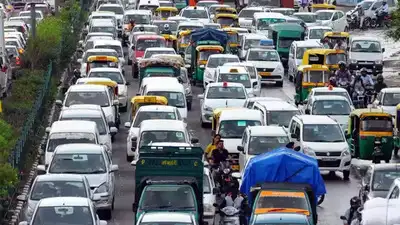
📌 Introduction
Delhi is all set to tackle its air pollution crisis head-on with a game-changing move starting July 1, 2025. Petrol and diesel pumps will refuse to serve fuel to overaged vehicles—diesel cars older than 10 years and petrol cars older than 15 years.
This significant directive, issued by the Commission for Air Quality Management (CAQM), aims to curb emissions from aging vehicles that are among the biggest polluters in the capital. For residents of Delhi, this policy means a cleaner future—but not without its share of challenges.
This article provides an in-depth analysis of the directive, including background, implementation details, and the incentives offered to ensure a smooth transition.
🌫️ Background: Delhi’s Air Pollution Crisis
Delhi has long suffered from severe air pollution, frequently ranking among the most polluted cities globally. One of the major contributors to this is vehicular emissions, particularly from older vehicles, which are more pollutive due to inefficient engines.
Although prior initiatives such as the implementation of Bharat Stage VI (BS-VI) norms, restrictions on new diesel vehicle registrations, and the promotion of electric vehicles (EVs) have had some positive impact, they haven’t fully solved the issue. The current fuel denial policy emerges as part of a combined short- and long-term strategy to phase out high-polluting vehicles.
🛠️ Specifics of the CAQM Directive
On April 23, 2025, the CAQM issued a directive mandating all fuel stations in Delhi to install Automated Number Plate Recognition (ANPR) cameras by June 30, 2025. These cameras will be integrated with the VAHAN database to identify EOL vehicles—defined as:
- Diesel vehicles >10 years
- Petrol vehicles >15 years
From July 1, 2025, such vehicles will be denied fuel at all petrol outlets in Delhi.
The directive forms part of a broader vehicle regulation framework in line with the Registered Vehicle Scrapping Facility Rules, which include penalties like impounding and scrapping for non-compliance.
📊 Key Aspects of the Directive
| Aspect | Particulars |
| Effective From | July 1, 2025 (Delhi); Nov 1, 2025 (select NCR districts); Apr 1, 2026 (others) |
| Categorical Vehicles | Diesel >10 years; Petrol >15 years |
| Enforcement | ANPR cameras at fuel stations, linked to VAHAN database |
| Legal Actions | Fuel denial, impounding, scraping under the Motor Vehicles Act, 1989 |
| NCR Rollout | Gurgaon, Faridabad, Ghaziabad, Gautam Budh Nagar, Sonipat (Nov 1, 2025); others (Apr 1, 2026) |
📅 Step-by-Step Implementation
- Delhi: Fuel denial begins July 1, 2025; ANPR installation by June 30, 2025
- Select NCR districts: Enforcement from November 1, 2025; ANPR installation by October 31, 2025
- Remaining NCR: Enforcement from April 1, 2026; ANPR setup by March 31, 2026
Additionally, from November 1, 2025, only BS-VI, CNG, LNG, or electric vehicles will be allowed entry into Delhi.
📈 The Extent of the Issue
As of March 2025, the estimated number of EOL vehicles is alarming:
| Region | EOL Vehicles |
| Delhi | 6,114,728 |
| Haryana | 2,750,152 |
| Uttar Pradesh | 1,269,598 |
| Rajasthan | 620,962 |
In 2024, Delhi authorities impounded 39,273 EOL vehicles, highlighting the scale of enforcement and the urgent need for the new policy.
Why This Step is Crucial
Delhi’s air quality has been a cause for concern for years, making headlines for being one of the most polluted cities globally. Vehicular emissions, especially from outdated engines, contribute heavily to this crisis.
While earlier measures like Bharat Stage VI (BS-VI) fuel norms and electric vehicle promotion have shown some impact, the city still struggles to breathe clean air. This fuel denial initiative could be the breakthrough Delhi needs to phase out polluting vehicles for good.
What This Means for Vehicle Owners
For vehicle owners, especially those dependent on older cars for their livelihoods, this move might come as a jolt. However, the government has lined up incentives to ease the transition:
· Tax rebates of up to 20% for non-commercial petrol and CNG vehicles, and 10% for diesel vehicles.
· Financial assistance for scrapping old vehicles and buying new, greener ones.
Owners can also apply for a No Objection Certificate (NOC) to use their vehicles outside Delhi or sell them to registered scrapping facilities.
🏛️ Government Stand
Both the CAQM and Delhi Government view the directive as essential for public health and environmental sustainability. A CAQM official stated:
“This measure is crucial for reducing vehicular pollution, which is a significant contributor to Delhi’s air quality crisis.”
This policy aligns with directives from the National Green Tribunal (NGT) and the Supreme Court on air pollution.
To support citizens, the Delhi Government, under Chief Minister Atishi, has introduced the following incentives:
💸 Tax Rebates:
- 20% on all non-commercial CNG and petrol vehicles
- 15% on commercial CNG and petrol vehicles
- 10% on diesel vehicles
🎫 To avail benefits, owners must obtain a Certificate of Deposit (CoD) from a registered scrapping facility and submit it within three years when purchasing a new vehicle.
How It Will Work
Fuel stations across Delhi will install high-tech Automated Number Plate Recognition (ANPR) cameras by June 30, 2025. These cameras will identify vehicles based on data from the VAHAN database, ensuring that only eligible vehicles can refuel.
Here’s what will happen:
· Diesel cars older than 10 years and petrol cars older than 15 years won’t get fuel.
· Non-compliance could lead to fines, impounding, or even scraping under strict enforcement rules.
The rollout will extend to select NCR districts like Gurgaon and Faridabad by November 2025, and other regions by April 2026.
Looking Ahead: Delhi’s Cleaner Tomorrow
Environmentalists have hailed this policy as a much-needed step for public health. While initial hiccups in implementation are expected, the government is working to expand public transport and improve EV infrastructure to make the shift smoother.
With its innovative use of technology and strict regulations, Delhi could set a precedent for other Indian cities to follow. The message is clear: It’s time for a greener, cleaner India.
✅ Conclusion
The CAQM’s directive to deny fuel to End-of-Life vehicles from July 1, 2025, marks a significant step forward in Delhi’s fight against air pollution. By combining strict enforcement with financial incentives and sustainable alternatives, the policy strikes a necessary balance between environmental responsibility and public adaptability.
Despite initial challenges, the long-term benefits for public health, climate resilience, and urban sustainability are undeniable. Delhi’s bold initiative could pave the way for a cleaner, greener India.
What do you think of this move? Share your views!






